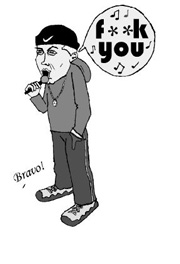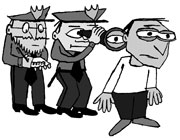This past weekend, two groups of people who care very much about radio assembled in Seattle, separated only by about 50 yards and 2 or 3 million light-years.
The catalyst was the annual radio trade convention of the National Association of Broadcasters (NAB), held this year at the Washington State Trade and Convention Center. While some 4,500 radio industry executives huddled inside, in the adjacent Freeway Park and Town Hall, their critics also convened: an umbrella of alternative-media agitators who titled their gathering “Reclaim the Media.”
It needs reclaiming, activists said, from the mass corporatization of recent years—especially since the Telecommunications Act of 1996—that has enabled companies to amass hundreds of radio stations across the country, all of them sounding exactly alike in their dullness.
The most striking feature of having the two groups side by side—aside from the disparity in wealth—was that both frequently proclaimed their passion for radio. But they meant different things. Outside, the activists talked of radio’s immediacy, its ability to engage our imaginations and local communities, and the things that could be broadcast. Inside, they enthused over radio’s ability to tailor itself to advertisers’ needs and to generate profits.
Radio, in the corporate model, is tomato sauce. While the scraggly protesters debated recipes, execs worried over how best to sell the sauce. The actual ingredients were a matter for subordinates. The contrast was clearest in an NAB session on the single issue protesters cared most about: a workshop titled “You’re Consolidated: Pros and Cons.” Remarkably, nobody—not the NAB’s moderator, panelists, nor audience members—could find anything bad to say about corporate consolidation of their industry.
Chuck Frederick of Clear Channel Communications—the nation’s largest chain, with over 1,200 stations, almost all of them bought since 1996—set the tone for the session. Frederick works in Cincinnati, where Clear Channel owns eight stations that reach 93 percent of that city’s listeners. He enthused of his industry’s consolidation that “I don’t know that we’ve done anything wrong,” and proclaimed that “Clear Channel is like a very kind gorilla.”
Notably absent from this year’s conference were vendors selling program content—while the NAB has always had a sales focus, this year what listeners actually hear on radio today was hardly mentioned at all. We’re an afterthought; what matters most is that we not be too offended by what we hear.
Nowhere is that truer than at Clear Channel. Frederick’s “very kind gorilla” gained notoriety in the wake of 9/11 for a widely circulated list of songs that individual stations should avoid, from the tasteless (“Dust in the Wind”) to the pointedly censorious (“Imagine,” “Peace Train”). In San Francisco last year, one of the country’s best-known hip-hop personalities, Davey D, was fired from Clear Channel’s KMEL for interviewing Rep. Barbara Lee on her vote against bombing Afghanistan.
Davey and others electrified a Town Hall crowd of over 1,000 Friday night. It was the high point of four days in which activists from the Net, low-power FM and pirate radio, cable-access TV, and all manner of print publications milled about trading strategies and wondering what was going on inside the NAB conference.
The answer would have been incomprehensible to most of them—sales seminars, mostly—but then, the vision held by the folks outside was equally foreign to most NAB attendees: that the media isn’t like tomato sauce, that it’s essential for the diversity of our music and culture and for the information citizens need in a democracy.
That’s a trait every other Western democracy recognizes with a mixture of privately and publicly funded radio and TV. Radio is different, not because of its selling power, but because it helps determine who we are as a people.
To some of the folks inside, that’s the same thing. By the end of the weekend, I was glad to be back outside.








